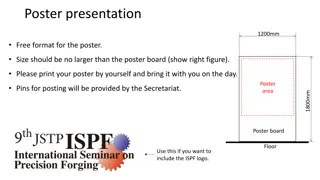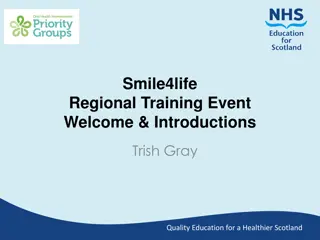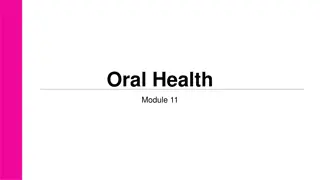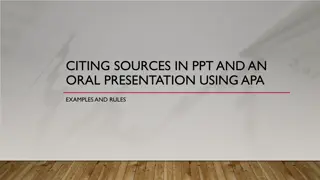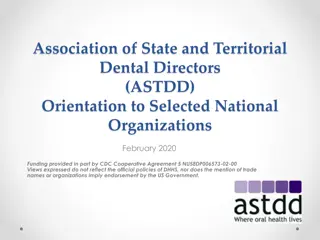Effective Strategies for Oral Presentations
Learn how to design and deliver impactful oral presentations by addressing content, mechanics, and audience engagement. Discover tips on structuring your talk, creating slides, and delivering an engaging introduction. Explore examples on presenting topics such as public relations in China and Japan, and gain insights into effective presentation styles.
Download Presentation

Please find below an Image/Link to download the presentation.
The content on the website is provided AS IS for your information and personal use only. It may not be sold, licensed, or shared on other websites without obtaining consent from the author.If you encounter any issues during the download, it is possible that the publisher has removed the file from their server.
You are allowed to download the files provided on this website for personal or commercial use, subject to the condition that they are used lawfully. All files are the property of their respective owners.
The content on the website is provided AS IS for your information and personal use only. It may not be sold, licensed, or shared on other websites without obtaining consent from the author.
E N D
Presentation Transcript
Overview This presentation will address the following: Content: How best to communicate your message. Mechanics: Slide preparation; Speaking style; and Presentation style.
Content Design your presentation for your target audience: Your peers and instructor. Do not keep your audience guessing: Organise your talk into the following components: introduction; body; and conclusion. Begin by providing an overview of your presentation: How your talk is organised.
Introduction Provide a clear introduction: introduce: yourself; your topic; the focus; and structure of your presentation (You can choose to have an overview slide) Inform audience when questions will be answered: interactive vs. question time at the end.
Example: Overview Slide Public Relations in China and Japan Infrastructural ingredients that are key to international public relations: Political system Level of economic development Level of activism These factors influence and are influenced by a country s culture and media. Both China and Japan have experienced a large amount of growth over the past 30 years.
Example: Introduction Begin with an appropriate greeting: Good morning, etc. Introduction of self: My name is ... Introduction of topic: Today we are going to talk about Public Relations within South- East Asia, focusing specifically on China and Japan. * Note: The purpose of this slide is only to provide you with an example. Do not prepare a slide with this information.
Example: Introduction (contd) Provide a brief background about the topic: International public relations is heavily influenced by three key factors... Topic Focus: While we believe that it is important to discuss all the factors associated with Chinese and Japanese public relations, for the purpose of this presentation we have chosen to focus on... Structure of Presentation: We will first begin by providing a brief background about public relations in China and Japan. Next, we will describe the political structure of both these countries... This will be followed by a description about... * Note: The purpose of this slide is only to provide you with an example. Do not prepare a slide with this information.
Body Keep it relevant; Keep it logical; Explain main points in detail; Refer to evidence; and Use language appropriate to your target audience.
Body: Components Introduction of the first point Link Expansion of the first point with evidence Link Introduction of the second point Link Expansion of the second point with evidence
Example: Body Background of Public Relations China Began in the 1980s Initially trialled in tourism and banking Undergone development over 30 years Currently, a respected practice Japan Brief but longer Traditional culture impacts practices More PR organisations Does not understand concept * Note: This is only an example. Remember to provide a regional perspective.
Example: Body Political Structure China Japan Communist state Japan - constitutional monarchy, governed by a Prime Minister One party, socialist republic The Emperor has very little political power Power exercised through the communist party of China * Note: This is only an example. Remember to provide a regional perspective.
Example: Body Economic Development China Japan 2nd rank(GDP- 6.1 trillion GDP/per capita 4382- 91th ) 3rd rank(GDP- 5.46 trillion GDP/ per capita 42,820- 16th) Only one party Multipartism- fight for their own members Huge gap between rich and poor areas Average Business, Tourist, Mining industry Cars, Electronic Staff, Agriculture * Note: This is only an example. Remember to provide a regional perspective.
Conclusion Restate thesis statement; Recap main ideas; Conclude with a statement summarising the interpretation of your findings; and Avoid ending with: That s all ; The end ; and Finished .
Presenting Your Content Consider your audience: what do they know about the topic? what do they not know? Tailor your presentation to be: interesting; informative; and appropriate.
Presenting as a Group Ensure that: you look like a group; there is cohesion and coherence between the different sections; the transition flows between the different speakers. Consider: where group members are going to stand; how they are going to step in to do their part; and the organisation of presentation.
Planning as a Group Research, write and prepare for the presentation together: Decide on who is going to say what; Prepare the slides together (consistency in format); and Save the presentation as a whole document. Practise as a whole group: Time each presentation; and Provide feedback to each other.
Mechanics of Presentation: Slides Include one main point per slide: use key words; add details verbally; audience should listen more and read less; and proofread your slides. * Note: Do not make your slides text-heavy.
Slide: Good or Bad? Chinese Culture The rituals of China are mainly based on the Zodiac Calender. Main Religions: Buddhism, Taoism, Islam, Catholicism and Protestantism. Saving face. There is a clear line between business and socialising. Large emphasis on non-verbal communication. (Kwinessential, 2004, Sriramesh and Vercic, 2009)
Slide Content Visuals should be: varied (graphs, charts, images, etc.); relevant to the topic; engaging; easy to see; and balanced with text.
Slide Content (contd) Background: Contrasts; Colours; and Patterns. Headings and Subheadings: Be consistent with fonts: size preferably >24 pt Effects: Keep it to a minimum; and Keep it academic and relevant. 32pt28pt 24pt 20pt18pt 32pt28pt 24pt 20pt18pt
Mechanics of Presentation: Speaking Style Speak rather than read: Use slides for support; Do not read from a prepared script; Use cue cards to jog your memory; and Engage your audience with a dialogue.
Pronunciation and Voice Speak at an even pace: Enunciate key words; Vary your intonation and word stress; Pause and stress on important terminology; Speak at an appropriate volume; and Project your voice but do not shout.
Mechanics: Presentation Style Body language: Gestures; Movement; Good or Bad? Position; and Posture.
Eye Contact Eye contact: Involve your audience by looking at them; and Look at each member of the audience at least once. Do not spend too much time: reading from your slides; and focusing on one spot in the room.
Time Management Time management: Be aware of the time; Keep the clock or your watch in view; Tailor your presentation for the allocated time; and Presentation should be well-paced.
Additional Points of Consideration Referencing: Academic tasks require wide reading; Audience need to know that you have sought expert, reliable sources; Use appropriate referencing style to acknowledge the sources in your slides; and Have a reference list as the last slide.
Additional Points of Consideration Preparation: First, practise by yourself; Do not exceed allocated time Next, practise as a group in front of a friendly yet critical audience; and Then, practise again by yourself. Look in the mirror: especially if you have just had a meal; and to adjust your clothes etc. to avoid any embarrassment.
Additional Points of Consideration Dealing with questions: Anticipate questions from the audience: Prepare answers If you cannot answer a question: Tell audience you will get back to them; Know your content: Do not appear surprised.
Summary An effective presenter: considers both the content and mechanics; organises the talk into clear components; communicates ideas logically, coherently and clearly; plans for the task as a group; prepares the slides so that message is: clear, interesting and error free; speaks well and engages with the audience; keeps within the allocated time; and uses evidence to support discussion.
References Huff, WAK 2008, Public speaking: a concise overview for the twenty-first century, Peter Lang, New York. Van Emden, J 2010, Presentation skills for students, Palgrave Macmillan, Hampshire, New York.

 undefined
undefined

















